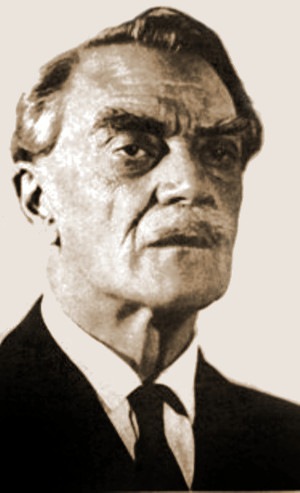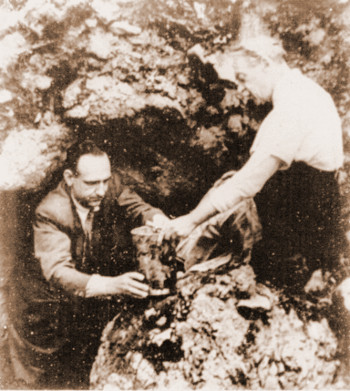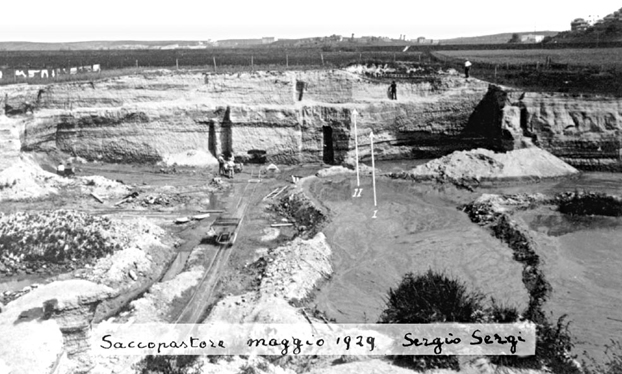Itinerary edited by SAPIENZA UNIVERSITY OF ROME 


Sergio Sergi (Messina 1878 – Rome 1972) is an internationally acclaimed, eminent exponent of morphology and paleoanthropology. Restless and insatiable in his scientific research, he was reserved and discrete in his private life. He held Luigi Pirandello, his fellow countryman, in great esteem, so much so that Pirandello inspired Sergi’s instructions for burial in his will: a private funeral, attended only by his wife and daughter. He let his scientific achievements do the talking. He was far from insensitive to issues of his time, especially those affecting his generation. When he was 19, as a first-year university student, he ran away from his parents' home to fight for the Greek cause against Turkey after the rebellion in Crete, together with a few volunteers under the command of Ricciotti Garibaldi. At the front in Domokos and Panaghia, like many of his peers, he was enraptured by the ideals of liberty and nation, which he perceived to be represented by Ancient Greece. Also his father Giuseppe had quit his law school to follow Garibaldi and fight in Milazzo.
When the conflict came to an end, Sergio Sergi resumed his studies and graduated in Medicine, with a dissertation on the physiology of the cerebellum. He completed his specialist studies in Berlin, at the Institute of Human Anatomy directed by Wilhelm Waldeyer, and the Institute of Anthropology directed by Von Luschan. Upon returning to Italy, he qualified as a University Teacher of Anthropology and won the competition for the post of director of “Santa Maria della Pietà” psychiatric hospital in Rome, which he held until 1924. Meanwhile he studied anthropometry, the nervous system of chimpanzees and anomalies such as microcephaly.
In 1925, he became professor of Anthropology at "La Sapienza" University of Rome. His studies on primate and human brains led him to collaborate with his father Giuseppe, and he succeeded him as Professor of Anthropology at "La Sapienza" University, as director of the Institute and the annexed Museum, in the Società Romana as well as in the «Rivista di Antropologia» (Anthropology Magazine). However, Sergio Sergi's contribution also drew inspiration from the anthropological method, with the design and creation of tools such as the pantogoniostato craniosteoforo, which became renowned worldwide.
He was also a member of several scientific associations in Italy and abroad, as well as the author of a remarkable number of publications, also international ones.
His research on the morpho-mechanics of the skeleton led him to design, create and perfect tools for osteometric measurement and as such he became a pioneer of modern geometric morphometry studies.

He provided fundamental observations on the two Neanderthals of Saccopastore (Rome) and the one from Circeo, which he referred to as Paleoanthropic. Since when they were discovered in 1929, 1935 and 1939, he dedicated himself to studying them. Today they are considered important scientific productions.
In 1938, Sergio Sergi refused to sign the infamous Manifesto of Racist Scientists. During this period, he published Le genti del Lazio attraverso i tempi (The people of Lazio over time), (Atti della Società Italiana per il Progresso delle Scienze, 1933), several biographies of anthropologists (including his father Giuseppe), the History of the Institute of Anthropology of Rome (1939) and numerous articles, in several languages, on fossils of Paleoanthropic Neanderthals.
His works on the Neanderthals of Saccopastore and Circeo not only focused on a comparative research of a morphometric nature, but also formulated more complex theories, such as the ones in I profanerantropi di Swanscombe e di Fontechevade (1953).
He also worked abroad: he participated in an archaeological mission in Fezzan and attended international scientific congresses and conventions. At one of these events (Düsseldorf in 1956, for the centenary of the discovery of the Neanderthal skullcap), he caused controversy upon questioning that the famous Prof. Jakobshagen of Marburg had found a new female Neanderthal skull. His observation of that finding led Sergi to believe it belonged to Homo sapiens, which was later confirmed by other experts.
During the last decade of his life and until his death in 1972, he conducted scientific research, taught and spread knowledge among younger generations: this was how he fought the bitterness he felt when he realised that paleontological studies in Italy were gradually declining.


1878 he was born in Messina
1897 he attended the first class at the Faculty of Medicine at the University of Rome.
1902 on 14th July he graduated with honours with a dissertation on the physiology of the cerebellum..
1902-1906 he worked in the anatomic-pathological laboratory of the Psychiatric Hospital of Rome and showed interest in the study of the nervous system of primates.
1906 -1907 he won a scholarship of the Ministry of Public Education to go to Berlin for a year and study the anatomy and physiology of the nervous system at the Institute of Human Anatomy.
1907 he qualified as University Professor in Anthropology and worked with his father Giuseppe.
1909-1924 Head Physician at the “S. Maria della Pietà” Psychiatric Hospital of Rome.
1916 he began teaching anthropology at the Faculty of Sciences at “La Sapienza” University of Rome.
1925 he became Head of Anthropology studies at the Faculty of Sciences of “La Sapienza” University of Rome.
1929-1932 he studied the fossil remains discovered in Rome (Saccopastore, 1929).
1933-1934 he participated in an excavation project in Fezzan (Libya), promoted by the Società Geografica Italiana.
1937 he presented the tool he had developed for the anthropometry of hair (tricocicloforo).
1935-1939 he continued his studies on the human remains discovered in Rome and Lazio (Saccopastore, 1929 and 1935; Monte Circeo, Grotta Guattari, 1939).
1938 Sergio Sergi did not sign the infamous Manifesto of Racist Scientists.
1949-1950 he perfected tools called Pantagoniostato craniosteoforo and assidiatetero for anthropological measurements.
1950-1956 his fruitful research in the field of palaeoanthropology enhanced his international prestige.
1962 William Howels invited him to participate in “Ideas on human evolution”, a collection with contributions from the most prestigious authors in the field of palaeoanthropology.
1972 he died in Rome.
 Rome
Rome
 Turkey
Turkey
 Greece
Greece
 Berlin
Berlin
 Libya
Libya
 Paris
Paris  London
London
 Naples
Naples
 Brussels
Brussels
 Zurich
Zurich
 Algeria
Algeria
 Vienna
Vienna
 Rome
Rome
Ascenzi A. (1974). Sergio Sergi. Discorso commemorativo pronunciato dal Linceo Antonio Ascenzi. Accademia Nazionale dei Lincei, Celebrazioni Lincee, 83, pp. 1-23, Roma, Accademia Nazionale dei Lincei.
Correnti V. (1980-81). L’antropologia fisica in Italia. Rivista di Antropologia, vol. LXI, pp.21-40. Correnti V. (1983). Contributi del Prof. Sergio Sergi alla Paleoantropologia. Rivista di Antropologia, vol. LXII, supplemento: pp. 41 – 84.
Correnti V. (1984-85). Il cammino dell’antropologia italiana. Sintesi storica. Rivista di Antropologia, vol. LXIII, pp.309-316.
Correnti V. (1984-85). L’Istituto di Antropologia dell’Università di Roma “La Sapienza”. Origini, vicende, attività. Rivista di Antropologia, vol. LXIII, pp. 323-338.
Correnti V., De Stefano G.F. (1989). Antropologia biologica in Italia- Parte IIA. L’Antropologia durante il I centenario della unificazione dell’Italia (1871-1970),Rivista di Antropologia, vol. LXVII, pp. 415-442.
Correnti V., De Stefano G.F. (1989). Antropologia biologica in Italia- Parte IIB. L’Antropologia nei primi due decenni dell’unificazione dell’Italia (1971-1989). Rivista di Antropologia, vol. LXVII, pp.443-458.
Cresta M., Destro-Bisol G., Manzi G. (1993). Cent’anni di Antropologia a Roma. Celebrazioni per il centenario dell’Istituto Italiano di Antropologia. Rivista di Antropologia, vol. LXXI, pp. 1-30.
Manzi G.(1984-85). Il Museo di Antropologia. Attualità di una istituzione centenaria. Rivista di Antropologia, vol. LXIII, pp. 375-378.
Manzi G. (1987). Il Museo di Antropologia dell'Università di Roma “La Sapienza”: una testimonianza del percorso intellettuale di Giuseppe Sergi nella seconda metà del XIX secolo. In G. Mucciarelli (a cura di), Giuseppe Sergi nella Storia della Psicologia e dell'Antropologia in Italia, pp. 127-137. Pitagora, Bologna.
Puccini S. (1993). L’Antropologia a Roma tra Giuseppe e Sergio Sergi. Rivista di Antropologia, vol. LXXI: pp. 229–247.
Sergi S. (1939). La Sede dell’Istituto di Antropologia dell’Università di Roma dalle sue origini al trasferimento nella città Universitaria (1884 – 1937) e il suo Trasferimento. Rivista di Antropologia, vol. XXXII: pp. XI – XXI.
Spedini G. (1982-83). Prospettive e finalità nel processo di rinnovamento dell’antropologia. Rivista di Antropologia, vol. LXII, pp. 327-332.
Vacca E. (1991). La morfologia antropologica del primo ‘900 in Italia e l’approccio analitico allo studio della forma. Rivista di Antropologia, vol. LXIX, pp. 39-48.